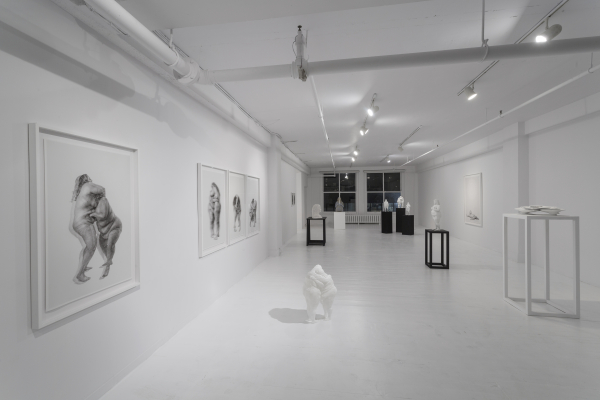( ) 14
- Fred LAFORGE
Altérations perceptives
Seeking to redefine the gaze that is usually focussed on atypical bodies, the work of Fred Laforge is primarily concerned with the perceptual ambiguities of beauty and normality. This body of work focuses on the obese body, as being both underrepresented and yet everywhere, while eliciting an ambivalent stance in Western culture. His art works exacerbate this uncertain status by being at the same time recognizably realistic and highly altered and deliberately blurred. The desire to represent this imprecision in regards to the assessment of such bodies is especially embodied in his formal strategies that suggest movement. Rather than move his works – for example with animation – Fred Laforge uses several techniques that seek to create optical effects that mimic trembling and oscillations, so as to shake up our perceptions. Through the destabilization of observation to the point of indistinction, the work reveals how our relationships with this body type is never fixed or stable.
The stratified sculptures made of wire armatures alternate solids and voids, combining presence and absence. This stratification also ensures that the works seem to vibrate when they are looked over and visually scanned. Similarly, in his digital prints, Laforge superimposes images that are slightly offset, and represents the impression of movement resulting in blurred images. In addition to evoking a blurring censorship that seeks to prevent the gaze, this effect is reminiscent of a moving subject and refers to the difficulty of capturing an image, while also referring to that which is “too much” – “too close” or “too far “- but especially that which is “abnormal” or excessive. Obesity is made flickering in the works, and is deliberately distanced from the notion of control that underpins a sharp image or a normative conception of the body. The work is not about a positive or negative body image, but about this uncertain in-between. The physical treatment of the materiality of the art works make palpable the unstability of judgments against corpulent bodies.
In the three-dimensional printed works, the decimation carried out on the volumetric pixels of the modelling renders visible a massing of polygons. Their rigid geometry cuts through the supple bodily forms of the models. This suppleness is exaggerated by a flattening or a squeezing, emphasizing the sense of horizontality that characterizes the expansion of the obese body. Through this work, the body becomes even more unformed and equivocal. These alterations amplify the formal richness of this type of massive physiognomy: the opulent texture of the skin and the underlying flesh, as well as the complex and sculptural curves of the drawing. Moreover, nudity adds to this formal beauty, exhibiting the carnal sensuality of abundance. Within a seductive play combining realism and alteration, attraction and repulsion, this body of work manages to question the phenomenen of a perceptual slippage that occurs when observing atypical bodies in different contexts, whether within art or in daily life.
Christelle Proulx
Fred Laforge lives and works in Montreal. In 2009 he earned a PhD in Arts at the l’Université du Québec à Montréal. His work has been exhibited in Canada and abroad in several solo and group exhibitions. He participated in the Manif d’art de Québec, Artransmédia in Spain, Space Movement in Chile and at the Biennale of Vrsac in Serbia. In 2011 he held several exhibitions including solo exhibitions at the gallery Occurrence (Montreal) and at the galerie Plein Sud (Longueil), group exhibitions in the gallery SAS (Montreal) in June and December 2011 and participated in the Foire Papier 11 (Montreal). In 2012, his work was presented at the artist-run centre L’œil de Poisson (Québec City) and at the SAS gallery for a large-scale solo exhibition. His work was also seen at the Scope art fair in New York. Fred Laforge has received numerous grants from the Council of Arts and Letters of Quebec and Fonds de recherche Société et culture du Québec. His works are in private and institutional collections including the National Museum of Fine Arts of Quebec.
Christelle Proulx completed a Master’s degree in Art History at the University of Montreal after earning her BA from Concordia University. Supported by the Fonds de Recherche Société et Culture du Québec and the Conseil de Recherches en Sciences Humaines, her research focuses on the study of visual culture and digital technologies. She recently has written on projects that use web images for the journal Ciel Variable, in addition to presenting various conferences on the subject. She is particularly interested in the practice of artists who work with “new” technologies.











